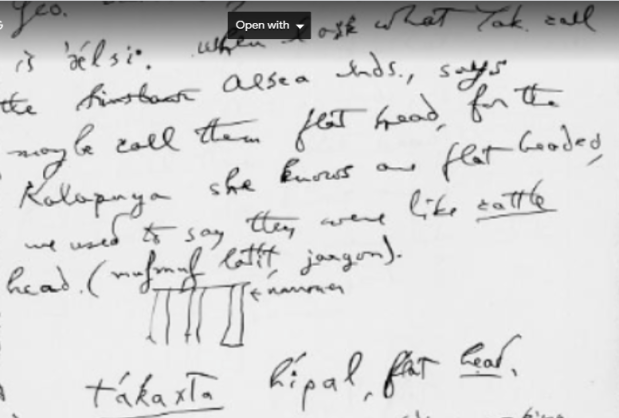Found: A Jargon word for ‘flat-headed Indians’
wəx̣t hayu masi kʰapa chup henli (thanks much, again, to Henry Zenk) for noticing & sharing this exquisite bit of what I call linguistic archaeology…
henli sent over some newfound information on Chinuk Wawa that’s just wonderful. He found a neat old CW expression for Native people whose foreheads were flattened in the traditional style. I’ll have him take over now…
..from Reel 28, image 0361 of the [John Peabody] Harrington papers, a Jargon term for flat-headed Indians. This is from a section of notes on Takelma language placenames, informants being Frances Johnson, Molly Orcutt, and Aneti Scott. I attach that image:
Of special interest:
“When I ask what Tak[elma] call the Alsea Inds, says maybe call them flat head, for the Kalapuya she knows are flat headed, we used to say they were like cattle head (muʃmuʃ lɑtít, jargon).”
Just below this there is a note referencing “Frances,” so I would surmise that Frances Johnson was the probable source. The comparison of flat-headedness to cattle heads was evidently in wider currency, as it also crops up in Clackamas Texts (p. 561, section titled “joshing during a spirit-power dance” by [Melville] Jacobs), countered by the comparison of round heads to “mauls”:
After a while some one or other would enter, they would be packing their children. 2. They (the older people already sitting and gossiping) would turn and look (at the new arrivals). [kílipašda] turned and looked and said to [niʔúdiya], “Well well well well the people coming are workers, they are packing their mauls (that is, their babies whose heads have not been flattened).” But James Winslow (a half-breed who spoke Clackamas) overheard them. Whereupon he said to them, “Oh yes! go laugh! If they were like your own heads, they would be just like cattle!
BTW, James Winslow was the “Chup [grandpa] Winslow” who, along with his wife Polly Winslow, raised Henry Petite Sr (John Petite’s father). [Grand Ronde Indians.]
This is Dave again — I’d add that, remarkably, we haven’t known a traditional term for ‘flat-headed’ in Chinuk Wawa until now.
It seems to me in conversations with Grand Ronde speakers, I’ve heard łə́q’əł-latét, a literal translation from Canadian French (la) tête plate or from English. That expression is about as old as the presence of those 2 European languages out here, but we haven’t found historical evidence for its use in Jargon.
You may notice at the bottom of today’s illustration, JP Harrington noted down an apparent Takelma-language term that literally means ‘flat head’, and it’s entirely possible that such expressions were used in various Indigenous languages.
- Cowlitz Salish ʔac-p’íƛ̓-ay’-s (literally ‘be-flat-on-face’) ‘flat face’ perhaps denotes flattened foreheads.
- A similar term in Upper Chehalis Salish is ƛ̓áq-ays (literally ‘long-forehead’) means ‘flat, upper part of a flattened head’.
- Kathlamet Lower Chinookan has iłáp’aqa ‘[to be a] flathead[ed person]’. I don’t know the literal meanings of the parts that make up this word, nor of the following.
- Kiksht/Wishram Upper Chinookan says iłxapáka for ‘flattened forehead’.
Anyway, we’ve never been able to clearly demonstrate that historical CW has said literally ‘flat head’.
So it’s quite lovely to learn a way that people did talk about this cultural trait in Chinuk Wawa, back in the day. This músmus-latét (‘cow-headed’) would seem to have come about after the Europeans and their cattle arrived, but from the testimony above, it’s old skool.


The word and page was actually found by me, I shared it with Henry
LikeLike
Pingback: “Músmus-latèt” people at Skeetchestn, BC! | Chinook Jargon